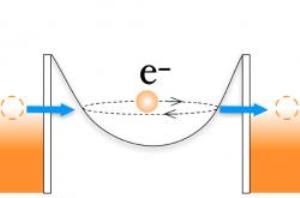A research group led by Gleb Finkelstein, a physicist at Duke University, has developed a simple system to explore the mechanism behind the travelling of electrons through energy barriers rather than over them.
 This graphic shows an electron using a resonant level (center well) to pass through an energy barrier (orange wall). (credit: Gleb Finkelstein; Duke)
This graphic shows an electron using a resonant level (center well) to pass through an energy barrier (orange wall). (credit: Gleb Finkelstein; Duke)
This particle behavior is called as tunneling. During their experiment to manipulate the environment of tunneling electrons utilizing carbon nanotubes and electrical leads, the researchers surprisingly found that they were able to produce a quantum phase transition, which is an unexpected change in the system’s quantum state. The researchers have described their results in the Nature journal.
Quantum phases happen at or near zero temperature and normally occur when there is a collective change in the characteristics of large group of particles such as electrons. Although quantum phase transitions are common in modern physics, they are difficult to study. For instance, electrons in superconducting materials prevail over their negative repulsion between each other and flow with minimal resistance.
According to Co-author, Harold Baranger, resonant tunneling is like a tiny island where one can hold the foot briefly. In the experiment, the researchers were seeking signs of resonant tunneling, in which the electrons jump onto the carbon nanotube when they traverse between the two electrical leads of the system. By forming an energy-draining environment in the electrical leads, the researchers measured how conveniently the electrons traversed the resonant level in the nanotube at very low temperature.
Finkelstein explained that the electrons take energy to force themselves for a jump at the leads and compared this phenomenon to swampy banks. Electrons can easily jump between the two banks when the resonant island is placed right between the banks. However, if the island is nearby to one of the banks, the electrons remain attached to either one of the leads. This unexpected behavior difference indicates a quantum phase transition, informed Finkelstein.
The findings provide a simple system that enables the testing of a variety of environments involving quantum phase transitions, concluded Baranger.